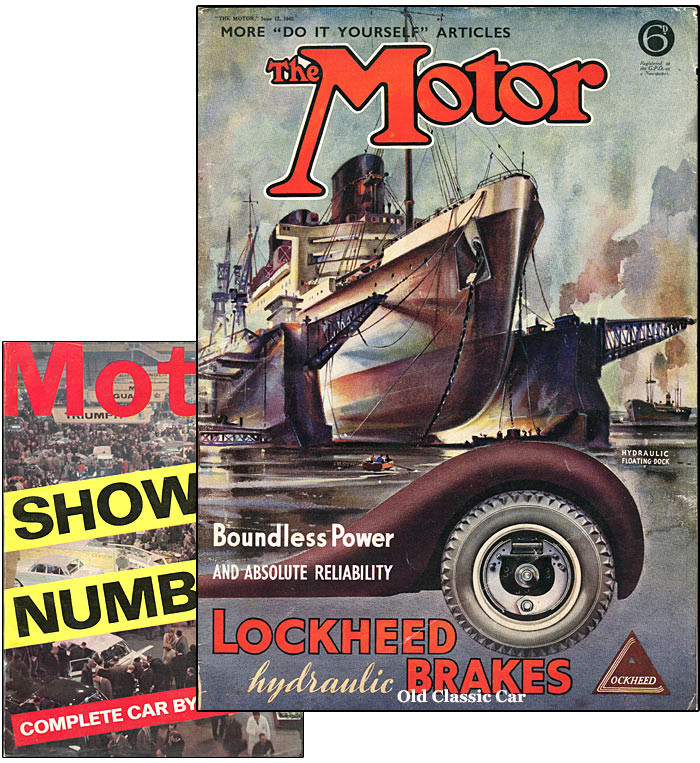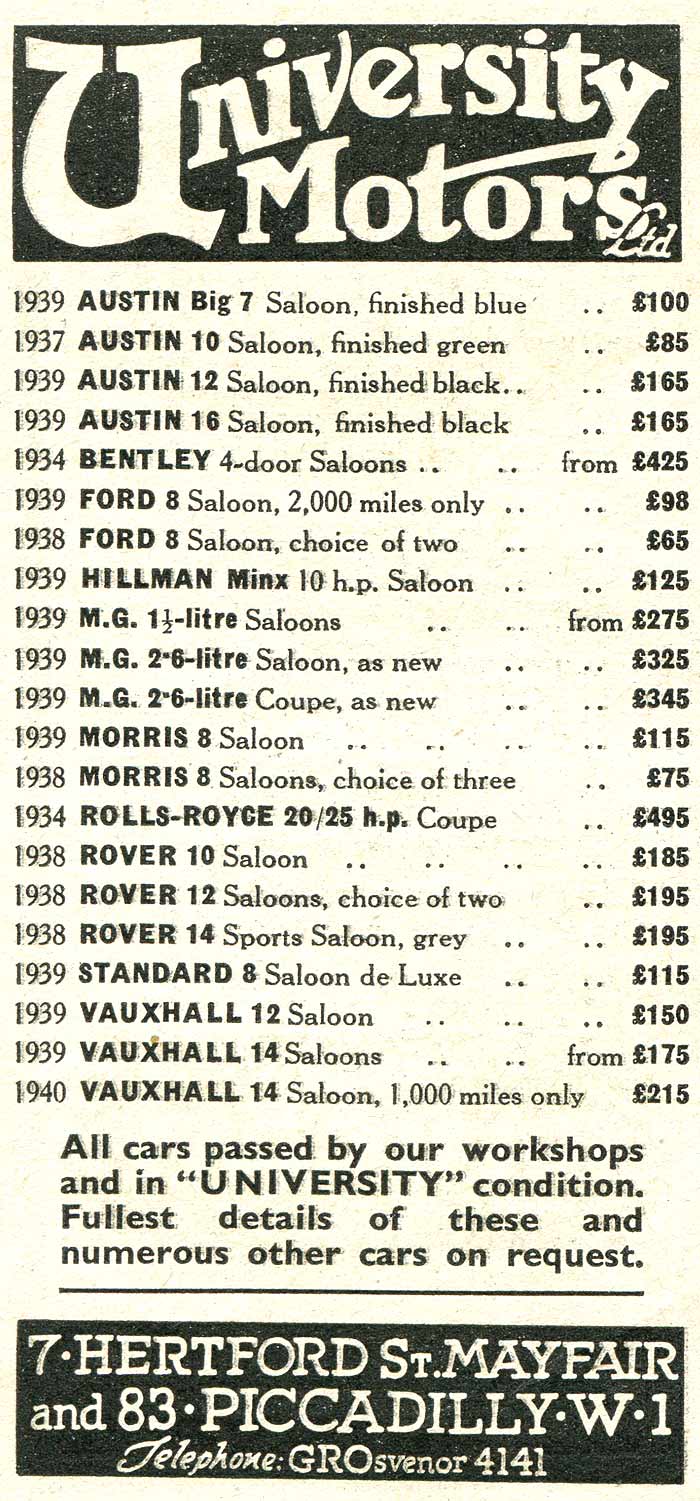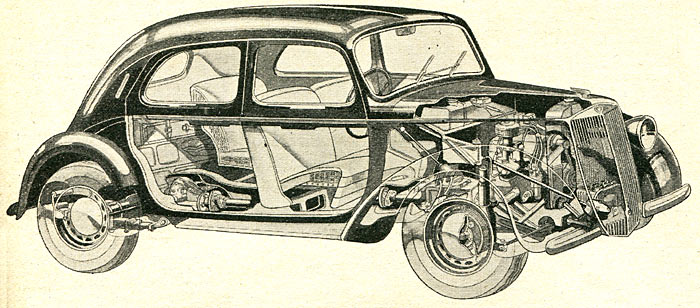The Motor.
Growing up in the 1970s, the two main new-car magazines that would often be found on the shelves of the local newsagent were "Autocar", and "Motor". In 1988, the former title would swallow up the latter, renaming the resulting single weekly publication as "Autocar & Motor". This would remain the situation until 1994, when "& Motor" was dropped altogether, leaving just "Autocar".
|
|
"Motor" can trace its routes back to the early years of the 20th Century. Initially named "Motorcycling and Motoring", it debuted in 1902, and was published by Temple Press Limited. It became "The Motor" not too long after, and remained with this title until March 1964 when it was shortened to just "Motor". The copies shown below date to 1940, and 1965, revealing just two of the variations of cover design that this magazine displayed during its lifetime. Given that it's a) the earlier copy, and b) dating to the Second World War, a time when life in Britain and across Europe was beginning to be turned on its head, this June 12th 1940 copy will now be looked at in more detail.
|

|
The Motor, June 1940.
The front cover bears a full-page advertisement for Lockheed hydraulic brakes. Unusually for a motoring magazine, the main cover illustration isn't related to cars or motoring, but in fact the Lockheed company's support for the war effort with their hydraulic floating dock. Inside the front and rear covers, is a list of the wartime motoring regulations that were in effect at the time, although these would be re-visited and altered as the war rumbled on. Around 50% of the regulations relate to lighting or the supply of motor spirit, while the remainder consider other aspects of vehicle use during wartime restrictions. These include a speed limit for example, which was set to 20mph during the hours of blackout in built-up areas. Motorists planning to drive at night also had to ensure that the bumpers and edges of mudguards and running boards on their car were finished in matt white.
|
|
The rules of the road with regard to learner drivers had also been re-written. Licences were still being issued, but the requirements for learners to be accompanied by fully-qualified drivers at all times, and only with L plates fitted, were dropped. Tests, the reader was advised, may well end shortly, but anyone with a need to drive would be able to do so, irrespective of whether a test had been passed.
|
|
Advice on what to do in the event of an air raid is also given. The driver must park up at the side of the road, in a garage, in a car park, or in an open space away from the highway. Leave the vehicle unlocked, but removing anything of value, then head off to a location of relative safety, such as a shelter. No journey could be resumed until the all-clear, or "raiders passed", signal had been given. Equally, if there had been a gas warning, drivers would need to wait until the all-clear has been confirmed by the ringing of hand-bells. Carriage of a gas mask was also required. At the time, private motorists - who were subject to fuel rationing - were limited to a monthly mileage of no more than 200 miles.
|
|
Several pages further on, motorists are reminded that any radio installations and aerials must be removed from their cars.
|

|
|
Perhaps unsurprisingly, a mere page-and-a-half is given over to new-car sales, although this is more than made up for by pages of Used Car sales towards the back of the magazine. Some dealers had new cars in stock at the time, and were probably keen to see them gone. A wide variety of British and foreign-built cars are to be found, less common makes hailing from the USA include Cord, Hudson, La Salle and Packard. There then follow miscellaneous adverts, headed by two for ARP (Air Raid Precautions) equipment. A 1/3 page is given over to caravans and trailers, with a similarly-sized "Cars for Hire" section following on from it.
|
|
The Editorial at the beginning of the magazine proper, discusses how motorists might best put to use the rationed fuel that was available to them. It also re-enforces advice the magazine had given previously, about how best to leave a car when not being used - bearing in mind that the threat of imminent invasion by the enemy was very real at the time ...
|
|
"One very important thing which motorists have been asked to do, and which, we regret to say, they are not doing, is to take steps when leaving the car unattended to prevent it being of use to a thief, parachutist or enemy, either resident here or landing in this country. Experience in Holland has shown that cars are of great assistance to an invading force, and those in drivable condition may be seized, to the disadvantage of their owners and their fellow citizens, should this country be invaded. The advice to prevent cars being used for this purpose is sound. We have set out in our columns in recent weeks simple precautions that can be taken. It is very important that those cars left anywhere, even in lock-up garages, should be rendered undrivable. It is also unwise to leave any property, likely to be of use to an enemy, in a car, such as maps, road books, cameras, field glasses etc."
|
|
One of the methods to "nobble" a car as suggested previously by the magazine, was to remove altogether the centre carbon brush in the centre of the distributor cap, thus breaking the chain in the ignition feed to the sparking plugs. One keen reader, whose letter appears on page 473, pours cold water on this idea, suggesting that this wouldn't necessarily immobilize a car in all instances. The editor in his reply agrees that in some case this is true, as the spark might jump the distance from the cap down to the rotor arm. Due to this, the recommended approach was simply to remove the cap in its entirety.
|

|
|
One of the reasons for my own interest in pre-war cars, is the fact that they all have a story with regard to living through six years of WW2. Which cars were used throughout, perhaps in support of the Home Guard or on ARP duties, and which were hidden away for the duration, awaiting their (hoped-for) return to the road in future peacetime? On page 457 (numbering continued week to week) the Chief Constable from Hull issued an appeal to owners of cars rated at 12HP or more in the area, fitted with a tow-bar, to come forward and loan their cars as necessary for the purpose of towing AFS (Auxiliary Fire Service) mobile pumps. The Red Cross also put out an appeal for donations of a small, 8/10hp car, that would have to be capable of covering up to 1000 miles per week.
|
|
With no new-car launches in Britain to occupy column inches, pages are given over instead to the maintenance of existing cars, very much in the spirit of "make do and mend" that applied to all aspects of life at the time. Saying that, any car launches of note from further afield might well make an appearance within the pages of "The Motor". Pages 465 and 466 are evidence of this, thanks to a report on a new Lancia V4, the Ardea, the smallest car in the company's range at the time. Interestingly, just two days before this issue hit the newstands on June 12th, Italy had declared war on France and the United Kingdom. I wonder whether the editorship would have continued with this story about a new car from Italy, had the country's declarations been made a few days earlier, allowing the copy here in Britain to be altered before going to print?
|

|
|
Considering that "The Motor" was a weekly publication, it can't have been easy to fill its pages. With the London Blitz and five more years of war to come, the challenge of putting together any magazine and keeping the presses rolling, was only going to get more fraught. That the magazine survived the war years at all is quite remarkable.
|
|
Return to the car magazines section, to read about other publications like this.
|








